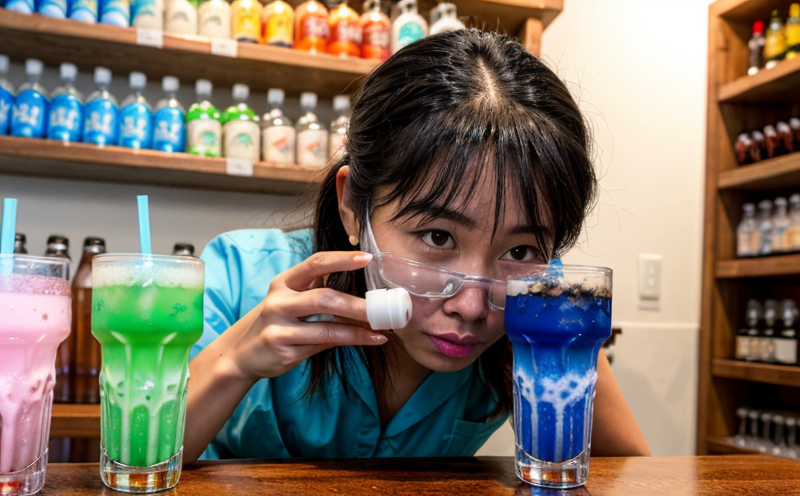ASTM D5847 Microbial Method Validation in Beverages
The ASTM D5847 standard is a critical tool used by laboratories to validate microbiological methods employed in the analysis of beverages. This method is essential for ensuring that analytical techniques meet the necessary accuracy, precision, and robustness required in quality assurance processes. Beverage manufacturers rely on validated methods to ensure product safety and compliance with regulations.
The ASTM D5847 procedure involves a series of steps designed to evaluate the performance characteristics of microbiological methods used for detecting microorganisms in beverages. These performance characteristics include:
- Specificity: The method should accurately identify only target organisms without cross-reactivity with other species.
- Sensitivity: It must detect low levels of contaminants, which is crucial given the potential presence of pathogens like Listeria monocytogenes or Salmonella in beverages.
- Detection limits: The lowest concentration at which a method can reliably identify contamination.
- Reproducibility: Consistent results across different analysts and laboratories.
The validation process typically involves inoculating test samples with known concentrations of microorganisms, running the sample through the proposed method, and comparing the results to those obtained from a reference method. This comparison helps establish whether the new method meets the required performance criteria.
Beverage manufacturers invest heavily in this type of testing because it directly impacts brand reputation and consumer trust. Inaccurate or unvalidated methods could lead to false positives (indicating contamination when none exists) or false negatives (failing to detect actual contaminants). Both scenarios are undesirable, as they can result in subpar product quality or overreactive safety measures.
ASTM D5847 is widely recognized and accepted globally. Its rigorous standards ensure that the methods used by laboratories adhere to best practices, thereby enhancing confidence among stakeholders. Compliance with this standard is often a requirement for regulatory approval of new products and processes.
The process of ASTM D5847 validation can be complex but essential for maintaining high-quality standards in the beverage industry. By adhering to these guidelines, manufacturers ensure that their testing methods are reliable and accurate, contributing significantly to product safety and consumer satisfaction.
Why Choose This Test
Quality and Reliability Assurance
The process of ASTM D5847 method validation is designed to enhance the reliability and accuracy of microbiological analyses in beverages. By adhering to this standard, laboratories can ensure that their methods are robust enough to detect even the lowest levels of contamination. This is particularly important for ensuring compliance with international regulations such as those outlined by ISO 17025 and FDA guidelines.
One key aspect of ASTM D5847 validation involves the use of challenge samples, which are prepared using known concentrations of microorganisms. These samples allow laboratories to assess the sensitivity and specificity of their methods. Another crucial element is the comparison between the results obtained from the proposed method and those from a reference method. This comparative analysis ensures that any discrepancies can be attributed to differences in methodology rather than inherent flaws in either approach.
The validation process also includes establishing detection limits, which define the lowest concentration at which a method can reliably identify contamination. By setting these limits appropriately, laboratories can ensure that their methods are sensitive enough to detect potential hazards without being overly conservative. This balance is essential for maintaining both product safety and cost-effectiveness in production processes.
Finally, reproducibility studies play a vital role in ASTM D5847 validation by verifying that the method yields consistent results across different analysts and laboratories. This consistency builds trust among stakeholders and ensures that the results are reliable and can be consistently reproduced when necessary.
In summary, ASTM D5847 method validation is an essential step towards ensuring the quality and reliability of microbiological analyses in beverages. By adhering to this standard, laboratories demonstrate their commitment to producing accurate, reproducible, and robust analytical methods that meet international standards for product safety and compliance.
Environmental and Sustainability Contributions
The ASTM D5847 method validation process has several positive impacts on environmental sustainability. By ensuring the accuracy and reliability of microbiological methods used in beverage testing, laboratories can help minimize waste associated with incorrect or redundant analyses. This contributes to more efficient resource use and reduced operational costs.
Moreover, accurate testing allows for better control over production processes, reducing the likelihood of batch rejections due to contamination issues. Such improvements lead to lower energy consumption during production and distribution stages since there is less need for corrective measures that could otherwise cause inefficiencies.
The use of validated methods also supports sustainable practices by ensuring that only genuine contaminants are identified, thus avoiding unnecessary recalls or product withdrawals. This not only protects consumer health but also reduces the environmental impact associated with disposing of potentially safe products.
Furthermore, compliance with ASTM D5847 helps manufacturers meet stringent regulatory requirements related to food safety and quality assurance. Meeting these standards can enhance a company's reputation as an environmentally responsible entity committed to producing high-quality beverages responsibly.
In conclusion, the rigorous validation process outlined in ASTM D5847 plays a significant role in promoting environmental sustainability within the beverage industry. Through enhanced accuracy and reliability of microbiological methods, laboratories contribute positively towards reducing waste, conserving resources, and supporting sustainable practices throughout the supply chain.





